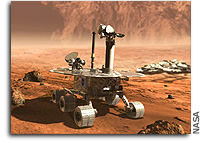NASA Develops Decision Suport Software for Mars Rover Mission

A new ground-based science planning support system developed for the
Mars Exploration Rover (MER) mission is helping NASA scientists
create plans and program computer command sequences for the twin
rovers’ daily operations.
Developed jointly by NASA Ames Research Center, Moffett Field,
Calif., and the Jet Propulsion Laboratory (JPL) in Pasadena, Calif.,
the Mixed Activity Planning Generator (MAPGEN) is a tool that
scientists say is critical to the success of the MER mission.
“MAPGEN is a software system that takes a collection of activities
that scientists want to do and builds a potential plan of action for
the rovers to execute the next day. It enables the human planner of
these activities to generate a robust, conflict-free plan, and
iterate on that plan numerous times to ensure the capture of the
scientific intent of the planned activities,” explained Kanna Rajan,
a senior research scientist at NASA Ames and the principal
investigator for the MAPGEN project.
With 150 scientists working ’round the clock during the first few
months of the MER mission, having a tool like MAPGEN is essential for
generating efficient daily operation schedules for the Spirit and
Opportunity rovers currently conducting science on the surface of the
red planet, according to Rajan.
“This is mission-critical software and the first application of an
artificial intelligence-based system for operating a platform on the
surface of another planet,” he said, adding that MAPGEN plans out a
whole day of activities for the rovers in advance. MAPGEN even
decides when the rovers wake up from their nightly slumbers to begin
the next “Sol,” or martian day, of activities.
MAPGEN is actually a combination of two previously built planning
systems: the Activity Plan Generator (APGEN), a manually operated
planner developed by JPL and EUROPA, an automated planning and
scheduling system developed at Ames Research Center. An earlier
version of EUROPA was flown as part of NASA’s Deep Space One Remote
Agent experiment in 1999.
MAPGEN took three years to develop by a team of scientists and
engineers and that team effort continues today, in support of the
tool’s successful use for planning the science activities for the
twin rovers on Mars.
“MAPGEN takes applicable science constraints and operations flight
rules into account when building a science plan. This capability
makes it straight-forward to build, modify and work with complex
science plans,” said Bob Kanefsky, an Ames engineer who is part of
the MER mission staff.
One of the keys to MAPGEN’s success is that it allows mission
scientists to be flexible in how they schedule their science plans
and objectives each day. The tool is capable of taking care of
numerous details that would take many people many hours to accomplish.
“MAPGEN is an automated tool with AI (artificial intelligence)
software, but with a human user in the loop, making it a mixed
initiative decision-support tool,” observed Ari Jonsson, a senior
research scientist with the Research Institute for Advanced Computer
Science at Ames. The result is that, while key decisions can still
be made by humans, the software takes care of required rule
enforcement and various routine daily tasks. In doing so, the
software reduces the complexity of the planning task and allows a
uniform enforcement of the flight and mission rules for the two
rovers when it generates a plan, Jonsson added.
For example, MER scientists may want the rovers to take a picture of
a rock or a panorama of Mars. By using MAPGEN, they can schedule that
activity to be accomplished in the most effective way possible,
having the software handle constraint and rule enforcement. The
software takes into account the potential conflicts associated with a
given task, and develops a schedule to overcome them. MAPGEN also
allows tasks to be prioritized. For conflicts that cannot be resolved
by clever timing, MAPGEN can reject lower-priority tasks according to
priorities set by the mission scientists.
According to Rajan and his team, MER mission personnel estimate that
the increase in science generated due to the use of MAPGEN is between
20 percent and 40 percent. With this demonstrated success in the MER
mission, scientists are optimistic that the technology will be an
invaluable tool for future Mars missions. MAPGEN is being considered
for use in NASA’s upcoming Mars missions in 2005, 2007 and 2009.
The MAPGEN project’s three-year development cost of $3.25 million is
funded by NASA’s Computing, Information and Communications Technology
(CICT) Program. CICT is part of the NASA Aerospace Technology
Enterprise’s Mission and Science Measurement Technology Theme to
develop crosscutting technology for a variety of space and aviation
applications.









